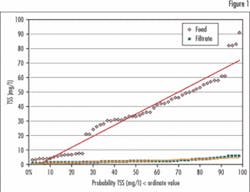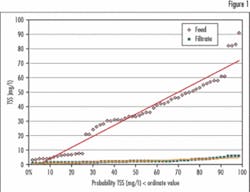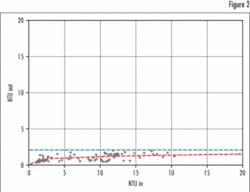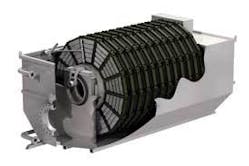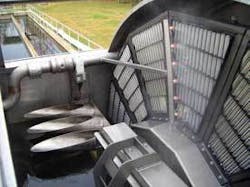by Miguel Gutierrez
U.S. municipal and industrial wastewater treatment plants have used disc filters for tertiary treatment since the early 1990s. The two predominant disc filter techniques - outside-in and inside-out - refer to the flow scheme through the filter unit. Each uses different filtration medium matrixes that correspond to the technique’s backwash needs. Although different in material and construction, both filter mediums produce a fairly consistent effluent quality that attests to their medium’s effective absolute pore rating. Compared to conventional sand filtration, the disc filters’ vertically oriented filtration area offers a smaller footprint for limited space and high treatment capacities.
Siemens Water Technologies recently introduced a new wrinkle to the inside-out technique by adding a pleated configuration to the filtration panels. This increased the available effective filtration area by 40% over flat panel designs. In addition, it improved the filtration panel’s overall strength for a higher operating headloss - 24 inches, or twice that of existing flat panel designs. This pleated configuration also allows the filtration panel to be less prone to media deformation and eventual reaping of the media due to headloss pressures over the flat panel’s stretched out surface.
The pleated filter panels are offered in the company’s new Forty-XTM disc filter system. With its higher filtration surface area and higher operating headloss capability, the system offers one of the greatest throughput capacities of any flat panel disc filter in the marketplace today. The robustness of the filtration panel seals are further complemented by the panel’s water-pressure-assisted design, eliminating the leak points common to existing flat panel designs.
To further the filtration panel’s design, the company’s filtration boxes (panel housing) are designed to allow trash material to flow through and be rejected out of the system. This is because the filtration boxes do not have internal gussets that can entrap large inorganic materials such as plastics, algae strings, rags and other floatables that can, in turn, affect internal hydraulics within the filtration panel.
The disc/drum’s entire internal assembly is covered with a stainless steel sliding cover. This cover eliminates the need to lift any cover segments and exposes sections of the disc assembly for ease of inspection and maintenance. This safety design feature is especially nice for outside installations during windy conditions.
The Siemens disc filter is designed as an all-inclusive stand-alone unit as well as a retrofit alternative for existing concrete structures that house conventional sand filtration technology. For example, the disc filter can more than quadruple the concrete structure capacity of existing traveling bridge filters. Considering the discs are solely in filtrate water and can sustain a wide range of headloss, minor modifications to existing structures usually only result in additions (whether metal works or concrete walls) to convey feed water to the disc/drum assembly.
The new disc filter system was tested with a production unit for several months at a pollution control facility in Thomasville, GA. The facility consists of trickling filter treatment followed by extended aeration secondary effluent. The test challenged the unit’s performance and determined operating parameters. A portion of the test included feed solids spike conditions. Figure 1 depicts a probability curve of the TSS performance, which shows the ability of the woven medium’s finite opening to achieve consistent effluent results. Regardless of feed concentration, the effluent is consistently low.
Figure 2 illustrates the performance curves associated with turbidity. All of these curves were generated at hydraulic loadings of 6 gpm/ft2 of true and effective filter area and 65% submergence. As expected, the higher the solids load, the more backwash volume was required to keep the media clean. These values, however, resulted in a low percentage of reject with a nominal value of 1% or less.
About the Author : Miguel Gutierrez is filtration products manager for the clarification and filtration product group at Siemens Water Technologies. Based in Thomasville, GA, he can be contacted via e-mail at [email protected].
